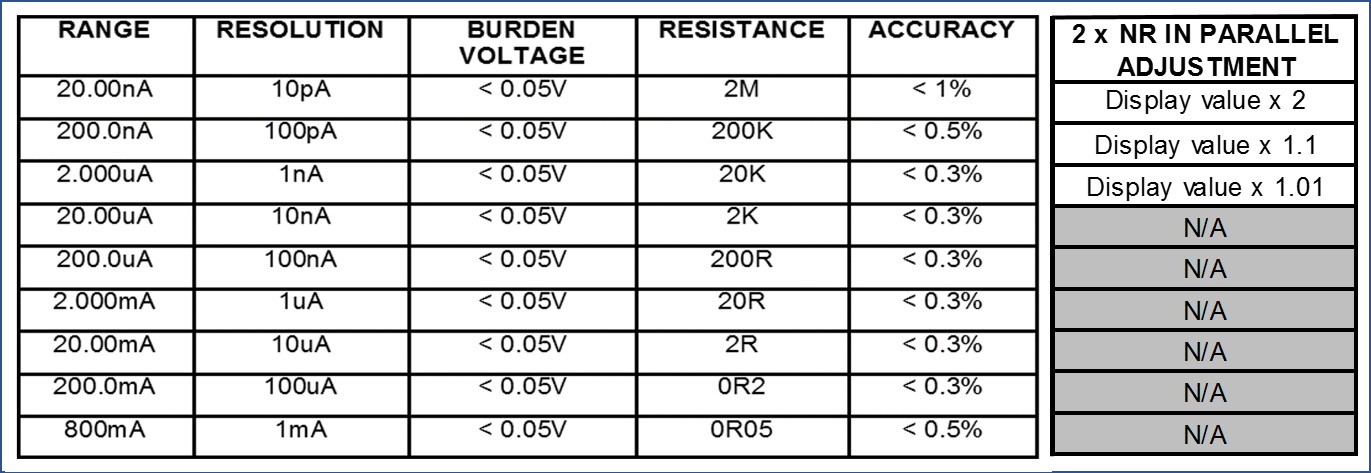NanoRanger® Applications
NANORANGER - Some Questions
Q: Can I measure Average current whilst NanoRanger is Auto-Ranging?
A: Yes! With Software V2.01 installed, you will see a Running Average reading, together with Measurement duration, displayed on the main screen. This calculation is not interrupted by Auto-Ranging. Total charge can then be calculated by the User from the displayed values.
Q: How do I get my PC working with my NanoRanger?
A: First, you'll need to establish comms with your NanoRanger:
• NanoRanger-01 requires a terminal programme to log data. We have used RealTerm.
• When you plug your NanoRanger in, it should install the device driver for the FT230X. This should then be seen by your system as a COM port.
• Right click on your Windows icon, select Device Manager, then select Ports (COM & LPT). You should then see the COM port with the port number (e.g. USB Serial Port (COM3)).
• Plug and Unplug your NanoRanger, to check that you are operating through the appropriate COM port.
• Select the correct COM port in the terminal programme, as per Peter Hanson's Guide (at the link below).
NB. The port may appear as \VCPn port under the port selection in RealTerm.
Second, having established comms, you'll be in a position to download, save, and interrogate your data. A guide describing this, produced by Peter Hanson, can be downloaded here.
Q: Is NanoRanger bi-directional?
A: A single NanoRanger is a uni-directional device. But two NanoRangers, harnessed in parallel, can take bi-directional readings. Please refer to the guide on this page.
Q: Can I use NanoRanger to take measurements in High Voltage circuits?
A: No. NanoRanger is designed and intended for use
only in Low Voltage applications.
Q: Is NanoRanger susceptible to noise?
A: Although it is not shielded, NanoRanger's circuitry is compact and not particularly susceptible to noise. Keep your probe leads as short as possible, however (around 30cm works well).
Q: Does my NanoRanger come with Probes?
A: Due to the wide range of applications that NanoRanger can support, it was considered environmentally unfriendly to include a specific set of probes that would be probably be discarded. Because NanoRanger's connectors are industry standard 4mm banana sockets, it is easy to integrate with existing test equipment.
An example of compatible probes can be found here.
Q: Does my NanoRanger come with a Case?
A: No, you will need to supply your own. A case for a 6" display SatNav should be adequate, but be sure to check the measurements.
DESIGNED BY ENGINEERS FOR PROFESSIONALS
Aren't we all trying to achieve optimum performance, within finite energy sources? As the power requirements of electronics reduce, battery life for devices will extend, so that device obsolescence may predate battery failure. Achieving this goal will continue to depend on designs performing as planned.
The trends towards Lower Power also mean that energy harvesting technologies become increasingly viable for substantially prolonging a device's working life. But again, being able to prove that these technologies are delivering, as predicted, is key.
NanoRanger® can help! It delivers exceptional accuracy across a range of current levels, providing a diagnostic, demonstration and measurement tool, ideal for these purposes. Cost-effective, battery powered and highly portable, NanoRanger is designed for use in the Lab and in the Field. The User can therefore assess device performance in ideal conditions, and then compare this against 'real world' results.
ENERGY HARVESTING
The User can couple NanoRanger® with a data logger and measure accurately the power delivery of energy harvesting solutions, over time. Doing so, across varying real world conditions, allows accurate power consumption modelling and accurate prediction of device longevity.
DESIGN ASSESSMENT AND OPTIMISATION
Does your device perform as intended? Do components meet claimed power usage? Are unexpected power levels apparent? Use NanoRanger® to:
- Get accurate readings of power consumption over time.
- Predict battery life.
- Measure the energy used in specific operations (e.g. GPS fixes, or in standby mode).
- Gain the insight needed to troubleshoot unforeseen power consumption events.
PRODUCT DEMONSTRATION AND EVALUATION
Using NanoRanger®, the developer can demonstrate, in real-time, their device's energy properties. Here's NanoRanger forming part of Atmosic's product Demo Kit (below)!
BI-DIRECTIONAL MEASUREMENT AND RECHARGEABLE TECH
A Client in California asked AltoNovus if NanoRanger® could support bi-directional measurement. A lot of work in the Low Power arena involves rechargeable devices, where the ability to measure current inflow and outflow is key. Although NanoRanger® was purposefully designed for uni-directional measurement for simplicity and to achieve maximum resolution, two NanoRangers, arranged in parallel, can do the job:
Of course, it is necessary to factor in the presence of the second NanoRanger® in the arrangement. For most measurements, the impact of the second device will be well within the margin of error for the range in question. However, at very low current ranges, the device in parallel will have an effect that must be allowed for. The adjustment to the observed reading should be applied as follows:
At the range in the example below, no adjustment is needed, as the device in parallel has a negligible effect on the reading.
However, at lower ranges, including the one shown in the pictures below, you will see that the reading must be multiplied by 1.1. This is to allow for the 1:10 ratio of resistance between the active NanoRanger and the device in parallel, which remains on the lowest measurement range.







